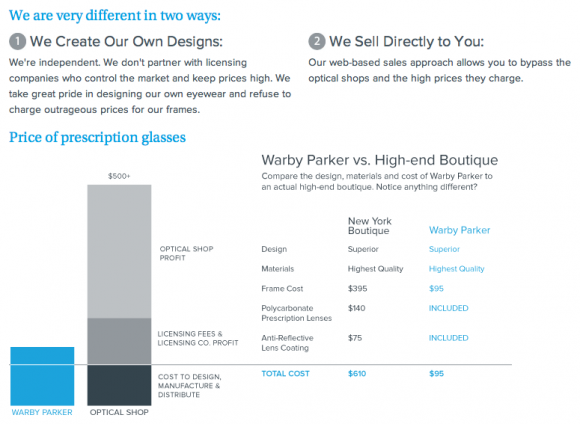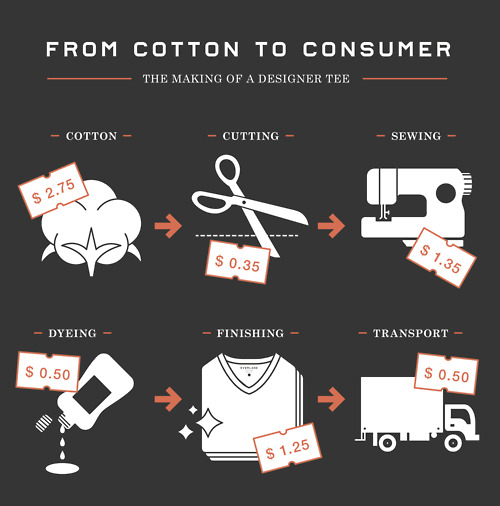The recent emphasis on authenticity in branding goes hand in hand with transparency – about business practices, provenance, and now pricing. Profit margins used to be sacred and not spoken of but companies are now using it as a marketing tool. Let’s look at some companies who use transparency about their goals and pricing to gain customer trust.
Warby Parker explains how they can price their eyeglasses so low with easy-to-read graphics.
Warby Parker sells complete eyeglasses for $95 through online sales. They talk extensively about how they achieve their pricing (mostly due to cutting out the middleman – local eyeglass boutiques who have a 2.5-3x markup). They also give a pair of glasses away via non-profits in countries to aid directly and via entrepreneurship. Truthfully, there are ways to get even less expensive eyeglasses, but talking about their bottom line combined with great photography and social media/word of mouth marketing has made this company a success story.
Everlane breaks down average costs to create a simple cut-and-sew garment.
Everlane, an online retailer of high-quality apparel basics, released an infographic that they say reflects the true costs of creating a T-shirt to sell. It helps to position their product as being sold at not only a good price but a fair price, compared to similar products sold for much more by fashion designers. The graphic itself is also a great, easily digestible bite of information that spread across the Internet like wildfire – never a bad thing for a business. (To see many, many more fascinating infographics, check out visual.ly.*)
How does transparency affect you? Shouldn’t being a handmade maker be reason enough for someone to buy from you?
These days, no. A consumer in 2012 is not only price-conscious, she is armed with many tools to help her find the best deal or sale on something she wants. She can do on-the-spot price comparisons on her phone and is bombarded with daily deals in her email.
A handmade artisan cannot and should not compete on price with a major manufacturer. However, the more education about what’s behind your pricing shows trust in the buyer and also can provide them multiple reasons to support your business. Here are some possible reasons you can present to your prospective customers:
- High-quality materials
- High-quality workmanship
- Use of recycled/reclaimed materials
- Providing jobs to others
- A unique and customizable product
- Supporting non-profit causes
- Great customer service
With these points, you are not justifying your prices for people who wonder why it is so high, you are instead making transparent your carefully considered product choices for those who care deeply about what they buy and who they buy it from. The difference is subtle, but important. Be upfront, don’t apologize!
As a bonus, keeping your customer up to date on your work practices is a great way to build an ongoing relationship, which is key to the health of your business. There are many ways to be transparent to your customers, via social media, volunteering for efforts that are important to you, and yes, even a great infographic. Find the method that works for you, and communicate your vision to the world.
*The danger of infographics is oversimplification. There is a very good rebuttal discussion at Well Spent about Everlane’s graphic, the designer clothing industry, local production and fair wages that is a must-read.



